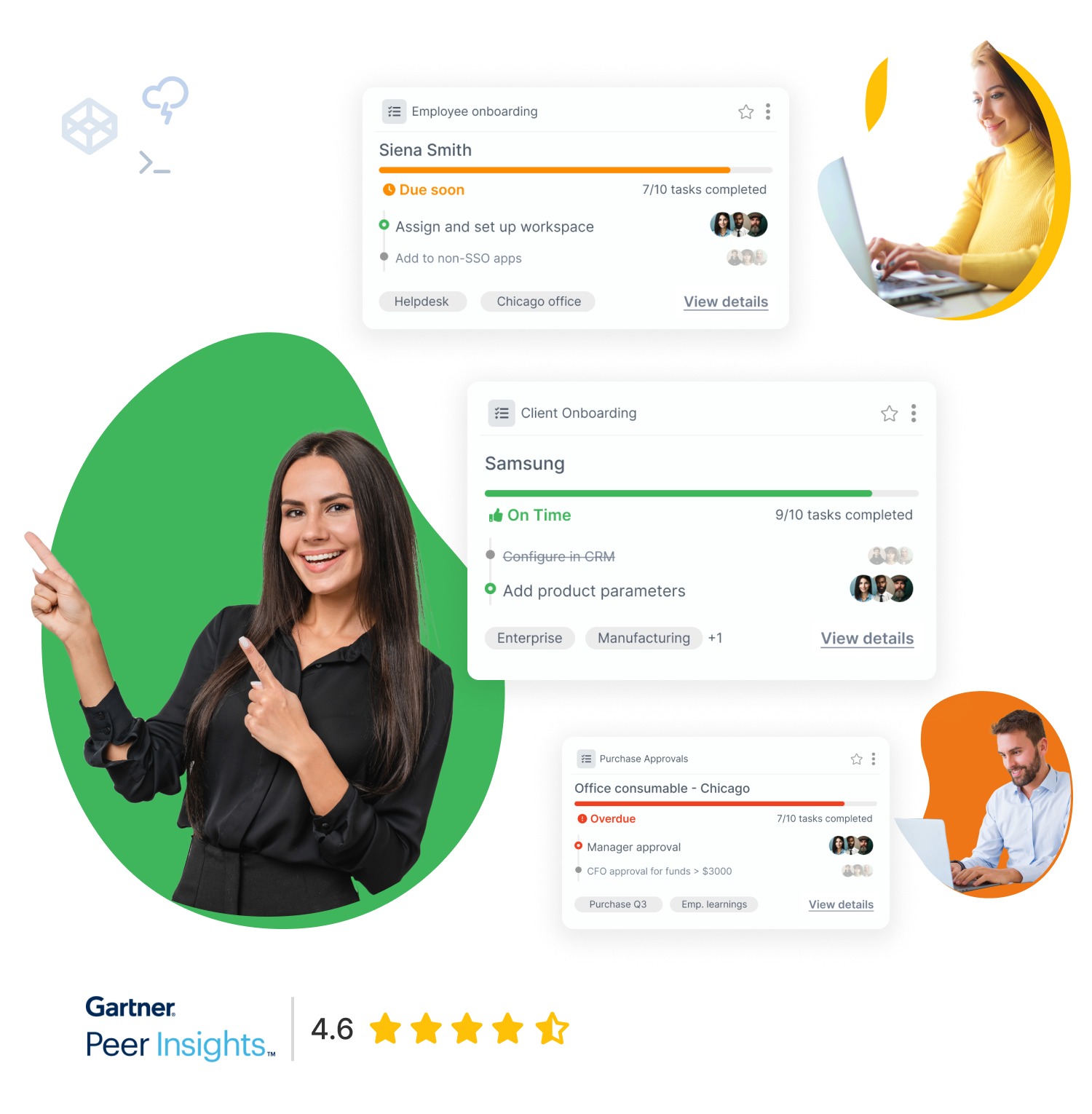Which do you think is the bigger risk after gaining a new account – losing the account because you don’t have any way of tracking new clients via client management software? Or because you onboarded the client too fast? The emphasis in client onboarding is often on speed, getting the paperwork done as fast as possible. But while efficiency is a great goal, especially when regulations must be observed, it’s only half the story.
Successful client management software must do two things:
- Ensure that your organization fulfills its obligations for compliance when providing your client with products or services. The “Know Your Customer” requirement for financial and legal organizations is an example.
- Reinforce the enthusiasm your client felt when signing up with your organization, taking the relationship to new levels of confidence and avoiding the risk of churn (i.e. the client ceases to do business with you.)
Timing is crucial in both cases, but the nature of the timing differs. In the first case, timing is “ASAP” for actions like entering or updating information on your client’s profile in your organization’s CRM, billing, and audit systems. In the second case, the ideal timing isn’t necessarily the fastest. Instead, it’s the one that keeps your organization best positioned in your client’s mind. The ultimate client management software actually exposes your client to every task they (and you) need to do – in one place.
Mapping Out the Timing of Many Moving Parts
The challenge is to coordinate these actions between the different people in your organization. Depending on what you supply to your client, customer service, legal, accounts, shipping, support, and billing departments may all be involved. The process rapidly becomes too complex to be managed reliably or efficiently using paper forms, spreadsheets, or email. However, with the right process management approach, client management software can help you initiate, pace, track, and complete tasks to keep your client happy and your organization compliant. A centralized software application can move the onboarding process along, automating actions, alerts, and nudges to keep things on track. Workflow applications like Tallyfy do this and also offer the possibility of integration with other systems, so information can be automatically transferred to a CRM for logging events, to accounts for invoicing, and so on.
How Do You Know When Each Action Within My Client Management Software Should Happen?
Experience is a good guide. People in your organization who have been successfully onboarding clients (clients who stay and who keep buying) will likely have a process and know how to pace the different process stages. That process with its timing must now be copied from out of their heads and into a generally accessible process that can be consistently and successfully applied by others. If this knowledge is hard to come by, you also have other options. First, check with your salespeople.
When top sales performers win accounts, they often use a repeatable, effective process, during which they make commitments to clients about what their organization will provide to them and when. So, not only can their process and timing inspire you, but you can also make sure those promises are respected in a timely way. Secondly, put yourself in the client’s shoes. Imagine when you would like to see each onboarding deliverable arrive. Then construct your process and timings accordingly.
Timing Unknowns and Variables and How to Handle Them
When defining the processes within your client management software using any of the methods above, keep the following in mind:
- Actions and timings cannot always be detailed up front. For example, if you are providing investment advice or advertising services, your first step may need to be a discussion about the right direction and strategy to adopt. Detailed steps and timings will depend on the outcome of that discussion.
- The timing for steps can vary. Some timing is fixed, either because actions are immediate or planned for the end of a given period: for example, a progress review three months after the client shows up as new in your client management software. Elsewhere, the timing of a process step may depend on a certain condition or result, for example, a level of sales or revenue achieved.
- Processes and timings can change. This may be because circumstances change or because you find a way to improve things.
The client process management solution you use should, therefore, make it easy for users, whether technical or non-technical, to add in new processes, shuffle steps if required, use conditional logic (“if this happens, then adjust timing like this”), and tune existing processes for better performance. The following examples of client management software processes and timings will also help make the picture clear.
Client Management Software Example for a Financial Services or Wealth Management Company
- Immediate: Team welcome letter, welcome package/kit sent to the client.
- Immediate: Due diligence (KYC and AML) to understand client’s source of funds and overall exposure to the client.
- IF due diligence is satisfactory: Client account created, linked to settlement and audit systems.
- IF due diligence is unsatisfactory: resolve or decline client’s business.
- Enter client profile and contact details into CRM and marketing automation system.
- Define frequency of contacts, for instance, seven or eight within the first 90 days.
- Set up ACATS (Automated Customer Account Transfer Service) as required.
- 1 week after signature: Optional step to send an additional token of appreciation to key accounts.
- 1 week after the first statement delivered: the First statement phone call.
- Within the quarter of account being opened: New client welcome reception.
- Continuing personal communications.
- 6 months: re-commitment meeting/call and client feedback session.
- Continue/ensure the client is now integrated into ongoing relationship management.
Client Management Software Example for a Marketing Agency
- Immediate: Check contract signed by client and deposit/retainer received, as applicable.
- Immediate: Send the client.
- copies of signed contract
- logins to any IT system you’ll be sharing (process management, collaboration, etc.)
- recap of your policies and promises
- personalized thank-you note
- Immediate: Enter client profile details in CRM and billing databases.
- Start of 4-week (or according to client needs) process leading up to kick-off with the client.
- Assess the client’s campaign requirements and assets.
- Assign team from your company.
- Initiate regular client communications (phone, email, other).
- Build marketing plan.
- Agenda for kickoff meeting: client overview, objectives, campaign, expectations, actions.
- Within 4 weeks: Hold kickoff meeting.
- Send weekly summaries of actions taken and results observed
- Make 60-day checkup call
- Continue/ensure the client is now integrated into ongoing relationship management.
Conclusion
Your client management software needs to be based on a repeatable process that is still flexible enough to handle particular client requirements or situations. It should be neither chaotic nor robotic. In other words, clients should not think your organization cannot manage onboarding correctly, but should not feel they are reduced to an account reference either. Onboarding builds on the great work your salespeople did in getting the client to sign up, to turn that initial commitment into a mutually beneficial relationship.
Drop us a line in the comments section below if you would like to know more about Client Management Software. With love, Tallyfy.
Related Questions
What is client management software?
A client management system software can help companies organize their customers, leads and dealings in one place. Think of it as a digital assistant that has all the knowledge in the world about your clients, from how to reach them to what products they like and when you last had a conversation. It’s sort of like you’ve got your own hyper-organized digital filing cabinet that gives you useful tools that will help you build more meaningful relationships with your customers.
What is a good free program to keep track of clients?
HubSpot CRM appears to be great for client management too, and its free! It offers contact management, deal tracking and email integration, and it’s free. Other worthy free options are Freshsales CRM and Zoho CRM, the latter which boasts a free version. These alternatives allow small businesses to get a handle on managing clients in the early days without breaking the bank.
What is the most popular CRM software?
Few companies can compete with the CRM behemoth that is Salesforce, which comes with a range of powerful and flexible services that stand head and shoulders above your average CRM platform. But what is in vogue is not always what is best for us. Other popular options include HubSpot, Zoho and Pipedrive. All have their pros – Salesforce for being the king of customization, Hubspot for marketing integration, Pipedrive for sales-driven features.
Which is the no. 1 CRM?
Salesforce is often called the market leader, but the “best” CRM for you will be based on your requirements. If you’re a small business, HubSpot may be a better choice. For salespeople, Pipedrive might just be. The key, though, is finding the software that is the best fit for your workflow, budget and plans for growth, and not just opting for the biggest name.
What are the best client management software options for 2025?
Beyond 2025: What to expect, the future best client management software solutions will be powered with AI and more automation. Leading contenders are Monday. com for its UI, Zendesk for the touch on customer service, and Freshworks for the important ease of use factor. Here’s the thing - cloud-based, mobile-accessible and workflow-automated systems (including ones like Tallyfy) are necessary to keep competing in the digital era.
How do I choose the right client management software?
Start by developing a list of must haves and any budget constraints. Consider the number of people you have on your team, the type of industry needs that drive your company and your growth plans. Experiment with a few through free trials — and ease of use, and the quality of customer support, in particular. And don’t forget, the prettiest or most expensive model is not always the best for you.
What features should good client management software include?
Its main functionalities are contacts management - task automation – integration of email and reporting. Document mobility, sharing, and workflow automation should also be part of new generation systems today. Look for a software with pipeline management, communication tracking and customizable dashboards to get everyone on the same page.
Can client management software improve customer retention?
Yes, significantly. With history of customer interactions, preferences and etc. you will be able to serve more personally and anticipate expectations of the client. Great client management software helps you keep up with your follow-ups, address problems before they become problems and stay in consistent communication with your customers.
How much should I expect to pay for client management software?
Pricing typically free to $100+ per user per month. Starting out, the basic plans are often around $15-30 per user per month, but once bells and whistles are added the total fees can be higher. You may not want to focus on cost alone, and measure the return on investment in terms of time saving and a happier client.
Is cloud-based client management software better than on-premise solutions?
Cloud based solutions are where the business benefits in the modern world generally are found. They are easier to access, receive updates and updates automatically, cost less up front and are easier to scale. They will also tend to be more interoperable with other tools and to provide a better mobile interface. But for companies in highly regulated verticals — such as healthcare and banking — on-premises software might still be an option due to security concerns.

